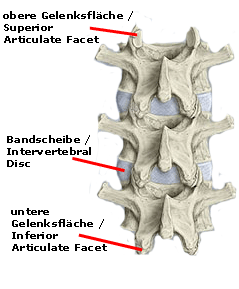 The normal anatomy of the spine is usually described by dividing up the spine into 3 major sections: the cervical, the thoracic, and the lumbar spine. (Below the lumbar spine is a bone called the sacrum, which is part of the pelvis). Each section is made up of individual bones called vertebrae. There are 7 cervical vertebrae, 12 thoracic vertebrae, and 5 lumbar vertebrae. An individual vertebra is made up of several parts. The body of the vertebra is the primary area of weight bearing and provides a resting place for the fibrous discs which separate each of the vertebrae. The lamina covers the spinal canal, the large hole in the center of the vertebra through which the spinal nerves pass. The spinous process is the bone you can feel when running your hands down your back. The paired transverse processes are oriented 90 degrees to the spinous process and provide attachment for back muscles. There are four facet joints associated with each vertebra.
The normal anatomy of the spine is usually described by dividing up the spine into 3 major sections: the cervical, the thoracic, and the lumbar spine. (Below the lumbar spine is a bone called the sacrum, which is part of the pelvis). Each section is made up of individual bones called vertebrae. There are 7 cervical vertebrae, 12 thoracic vertebrae, and 5 lumbar vertebrae. An individual vertebra is made up of several parts. The body of the vertebra is the primary area of weight bearing and provides a resting place for the fibrous discs which separate each of the vertebrae. The lamina covers the spinal canal, the large hole in the center of the vertebra through which the spinal nerves pass. The spinous process is the bone you can feel when running your hands down your back. The paired transverse processes are oriented 90 degrees to the spinous process and provide attachment for back muscles. There are four facet joints associated with each vertebra.
A pair that face upward and another pair that face downward. These interlock with the adjacent vertebrae and provide stability to the spine. The vertebrae are separated by intervertebral discs which act as cushions between the bones. Each disc is made up of two parts. The hard, tough outer layer called the annulus surrounds a mushy, moist center termed the nucleus.

When a disc herniates or ruptures, the soft nucleus spurts out through a tear in the annulus, and can compress a nerve root. The nucleus can squirt out on either side of the disc or in some cases both sides. The amount of pain associated with a disc rupture often depends upon the amount of nucleus that breaks through the annulus, and whether it compresses a nerve. To help alleviate the pain, a Laminotomy/Microdiscectomy may be performed.

THERAPY FOR SPINE PAIN
SCOI has Physical Therapy Facilities in our Van Nuys, Simi Valley, Thousand Oaks offices. Our therapists work closely with your physician in order to return you to full function and pain free activity as soon as possible.


